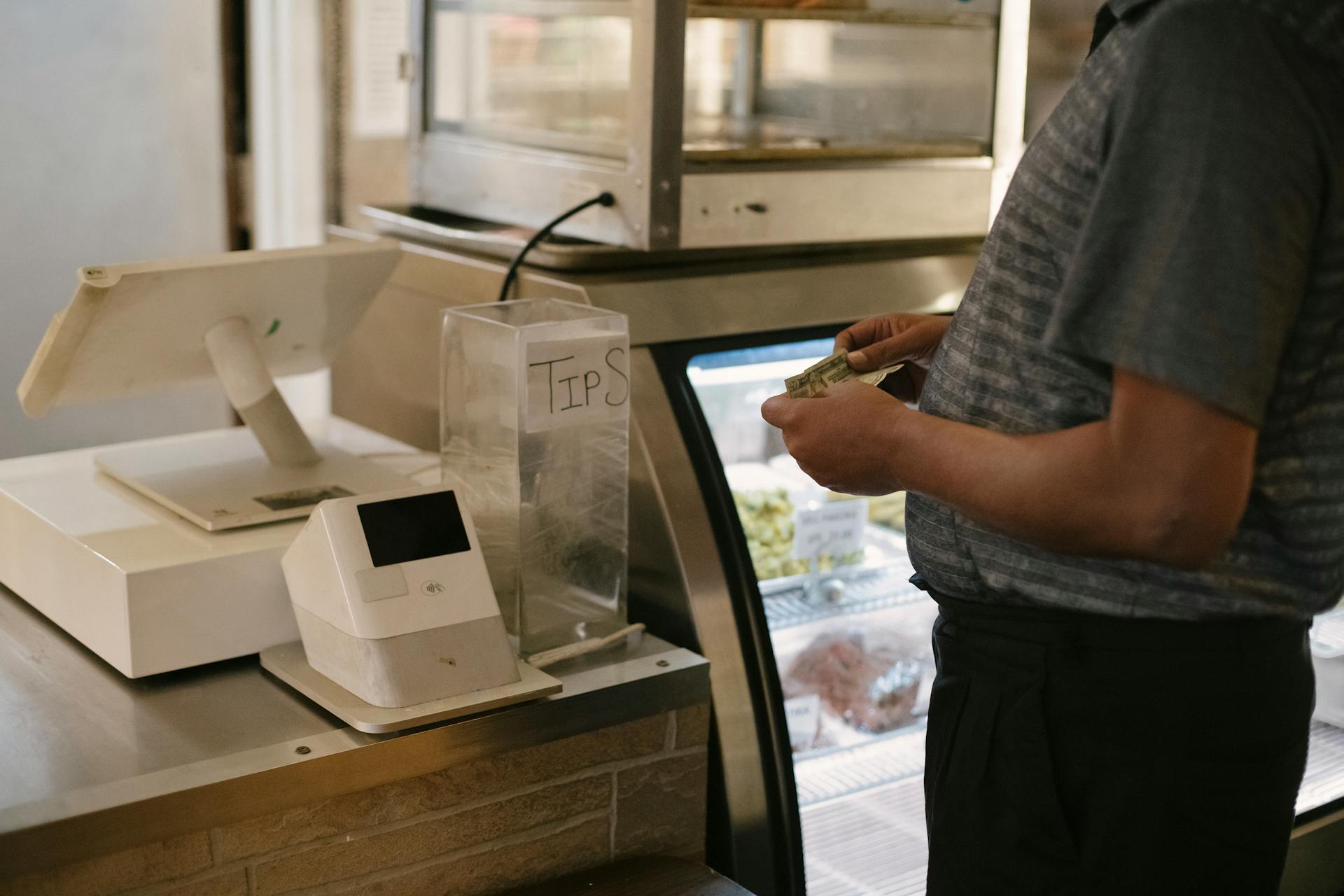
The Federal Reserve's decision to buy government securities has a significant impact on the economy. By purchasing these securities, the Fed injects liquidity into the financial system.
This injection of liquidity can lead to lower interest rates, making borrowing cheaper for consumers and businesses. As a result, people may be more likely to take out loans to finance purchases, such as homes or cars.
Lower interest rates can also boost economic growth by encouraging businesses to invest in new projects. This is because borrowing is cheaper, making it more attractive for companies to expand their operations.
The Fed's actions can also influence the value of the dollar. When the Fed buys government securities, it increases the money supply, which can lead to a decrease in the value of the dollar.
Explore further: Ubs Securities
Federal Reserve Operations
The Federal Reserve uses open market operations to buy and sell government securities, which has a significant impact on the economy. This tool is considered the most flexible option for the Federal Reserve.
The Federal Reserve Bank of New York conducts open market operations, under the oversight of the Federal Reserve Open Market Committee (FOMC). The FOMC makes a plan for open market operations over the short term and publicly announces it after their regularly scheduled meetings.
By buying and selling US Treasury bills on the open market, the Federal Reserve hopes to change their yields, which will then affect the interest rates in the broader market. The Fed's goal is to adjust the supply of reserve balances so as to keep the federal funds rate around the target established by the FOMC.
The Fed can lower the interest rate by purchasing securities and injecting money into the money supply. Similarly, it can sell securities from its balance sheet, take money out of circulation, and put upward pressure on interest rates.
The Fed's open market operations can be permanent or temporary. Permanent OMOs involve the outright purchase (or sale) of securities, while temporary OMOs involve buying or selling securities with the agreement to reverse the transaction in the near future.
Here are the key effects of the Fed buying government securities:
- Buying securities adds money to the system, lowers rates, makes loans easier to obtain, and increases economic activity.
- Selling securities removes money from the system, raises rates, makes loans more expensive, and decreases economic activity.
By engaging in open market operations, the Fed injects or drains funds from the nation's money supply. This tool is used to stimulate or slow down the economy, and it can be used in conjunction with other monetary policy tools to achieve the Fed's goals.
For more insights, see: Country Gravity Fed Smoker
Monetary Policy
The Federal Reserve's decision to buy government securities can have a significant impact on the economy. When the Fed buys Treasuries, it's essentially pouring cash into the banks, encouraging them to lend more to consumers and businesses.
This leads to lower interest rates, making it easier for people to borrow money to buy things or expand their businesses. As a result, consumers are more likely to spend and businesses are more likely to grow.
The Fed can also use this policy to contract the money supply and decrease demand. By selling Treasuries, it pulls money out of the system, causing interest rates to rise and borrowing to decrease. This can slow down economic activity.
In extreme cases, the Fed may even give up control of its portfolio and money stock to maintain a specific interest rate, as it did during World War II. This was the case in 1942, when the Fed committed to keeping short-term Treasury bills at 3/8 percent and long-term Treasury bonds at 2.5 percent.
Additional reading: When Did I Buy This Phone?
The goal of this policy was to stabilize the securities market and provide cheap financing for the government to fund the war effort. Marriner Eccles, the Fed chairman at the time, favored alternative methods, but ultimately agreed that providing cheap financing was the most effective way to support the war effort.
The Fed's monetary policy can be either expansionary or contractionary, depending on its goals. An expansionary policy aims to expand the money supply and boost demand, while a contractionary policy aims to contract the money supply and decrease demand.
Interest Rate Mechanism
The interest rate mechanism is a crucial tool used by the Fed to influence the economy. The Fed can set a reserve ratio, which is the required reserves (percentage of deposits) that a bank must hold either on site or at the Fed. This requirement must be satisfied on a daily basis.
Banks can seek to borrow from other banks holding funds at the Fed, and the rate they charge each other is referred to as the Federal Funds rate, or Fed Funds rate for short. The Fed indirectly influences and targets this rate through open market operations.
The Fed buys government bonds to increase the money supply and sells the same bonds to reduce it. Adding to the money supply typically leads to lower interest rates, while reducing the money supply increases interest rates. The Fed actively adjusts the buying and selling of bonds to achieve the target interest rate.
The Fed doesn't set the fed funds target rate, it only issues a range that it targets through active management of the money supply. The Fed communicates this range to the public as a standard part of the Fed Open Market Committee communications.
A fresh viewpoint: What Is Government Bonds and Securities
Quantitative Easing (QE)
Quantitative Easing (QE) is a powerful tool used by the Federal Reserve to stimulate the economy. The Fed buys long-term debt securities, like U.S. government debt and mortgage-backed securities, to lower interest rates and boost borrowing.
By buying these securities, the Fed reduces their supply in the market, causing private investors to bid up the prices and lower their yield, known as the "portfolio balance" effect. This is particularly important when the Fed purchases longer-term securities during periods of crisis.
Broaden your view: Examples of Secured Debt
Lower Treasury yields are a benchmark for other private sector interest rates, such as corporate bonds and mortgages. With low rates, households are more likely to take out mortgage or car loans, and businesses are more likely to invest in equipment and hiring workers.
The Fed's large-scale asset purchases, like those during and after the global financial crisis, had a significant impact on lowering 10-year Treasury yields. In the two years following the pandemic, the Fed bought over $4.5 trillion in Treasury and mortgage-backed securities.
These bond purchases can also impact market expectations about the Fed's future path of monetary policy, signaling its intention to keep interest rates low for some time.
Tapering
Tapering is the gradual slowing of the pace of the Federal Reserve's large-scale asset purchases. Specifically, this means the Fed reduces the monthly pace of its Treasury and mortgage-backed securities purchases.
The Fed's motivation for tapering is to slowly remove the monetary stimulus it has been providing the economy. According to guidance the Fed issued in December 2020, tapering was to begin once the economy had made "substantial further progress" toward its goals of maximum employment and price stability.
The Fed's balance sheet is much bigger now than it was during the last tapering period, and the economy is much stronger with higher inflation. This is why the Fed is tapering at a faster pace than it did under Janet Yellen's leadership.
What Is Tapering?
Tapering is the gradual slowing of the pace of the Federal Reserve's large-scale asset purchases. This means the Fed is not reducing its balance sheet, but rather slowing down the rate at which it's expanding it.
The Fed's motivation for tapering is to remove the monetary stimulus it has been providing the economy. This is done by slowing down the pace of its asset purchases.
The Fed's policy setting committee, the Federal Open Market Committee (FOMC), decided its taper test had been met in November 2021. This allowed the Fed to begin reducing the monthly pace of its Treasury purchases by $10 billion and its MBS purchases by $5 billion.
The Fed doubled the pace of tapering at its December 2021 meeting. This was a faster pace of tapering than occurred under Fed Chair Janet Yellen, who slowed purchases over a 10-month period between December 2013 and October 2014.
Tapering not only reduces the amount of QE, but also serves as a forewarning of tighter monetary policy to come.
The Taper Tantrum
The Taper Tantrum was a market reaction to the Fed's announcement of tapering in 2013. The Fed had been purchasing Treasury securities and mortgage-backed securities to stimulate the economy, but Chairman Ben Bernanke hinted at a slowdown in these purchases, causing a surprise increase in market interest rates.
This increase, known as the taper tantrum, was relatively mild, with the economy growing at a rate of 2.6 percent in 2013 despite fiscal and monetary tightening. However, it had greater effects on financial markets abroad, driving capital outflows and currency depreciations in emerging markets like Brazil, India, Indonesia, South Africa, and Turkey.
The taper tantrum was triggered by Bernanke's words in Congressional testimony on May 21, 2013, which caused a 9-cent increase in 10-year Treasury yields over the next day. This was followed by further increases in yields as Bernanke elaborated on the plan for tapering after the June FOMC meeting.
The Fed eventually began to taper in December 2013, reducing the pace of asset purchases from $85 billion per month to $75 billion per month. This reduction was phased in over several meetings, with purchases eventually ending in October 2014 and the Fed beginning to shrink its balance sheet in October 2017.
Permanent Operations
The Federal Reserve uses a tool called Permanent Open Market Operations to adjust the money supply and achieve traditional goals. This involves outright purchases or sales of securities from its portfolio.
The Fed will adjust its holdings to put downward pressure on longer-term interest rates. This is done to improve financial conditions for consumers and businesses.
Permanent OMOs are also used to reinvest principal received on currently held securities. This is a way for the Fed to maintain its portfolio and keep the money flowing.
The opposite of Permanent OMOs are temporary open market operations, which involve repurchase and reverse repurchase agreements. These are designed to temporarily add reserves to the banking system or drain reserves from it.
By using Permanent OMOs, the Fed can influence a variety of other rates, including savings deposit rates, home mortgage rates, and credit card interest rates.
Key Concepts
The Federal Reserve's use of open market operations is a crucial tool in influencing the economy. It's a way for the Fed to buy or sell government securities in the open market to affect the money supply.
The Fed uses open market operations to manipulate interest rates, starting with the federal funds rate used in interbank loans. This is a key part of its toolkit.
Buying securities adds money to the system, lowers rates, makes loans easier to obtain, and increases economic activity. It's a way for the Fed to stimulate the economy.
Selling securities removes money from the system, raises rates, makes loans more expensive, and decreases economic activity. This can help curb inflation or slow down an overheating economy.
Open market operations are one of three tools used by the Fed to affect the availability of money and credit. The other two tools are not specified in the article section, but it's worth noting that the Fed has a range of tools at its disposal.
Here's a quick summary of the effects of buying and selling securities:
- Buying securities: adds money to the system, lowers rates, makes loans easier to obtain, and increases economic activity.
- Selling securities: removes money from the system, raises rates, makes loans more expensive, and decreases economic activity.
Understanding Operations
The Federal Reserve has several tools at its disposal to reach its monetary policy objectives, but open market operations are considered the most flexible option.
The Fed conducts open market operations by buying and selling government securities on the open market, which is typically done by the Federal Reserve Bank of New York.
By buying government securities, the Fed increases the money supply and lowers interest rates, making it easier for banks to lend to consumers and businesses.
The Fed's goal is to keep the federal funds rate, the interest rate at which depository institutions lend reserve balances to other depository institutions overnight, around the target established by the Federal Reserve Open Market Committee (FOMC).
The FOMC makes a plan for open market operations over the short term and publicly announces it after their regularly scheduled meetings.
The Fed's open market operations are used to adjust the supply of reserve balances so as to keep the federal funds rate around the target established by the FOMC.
In an expansionary policy regime, the Fed purchases government securities from a bank in exchange for cash, increasing the bank's reserves and allowing it to lend to other banks in the federal funds market.
The Fed's open market purchase increases the supply of reserves (money) to the banking system, and the federal funds rate (interest rate) falls.
The Board of Governors of the Federal Reserve sets a target federal funds rate, and the Federal Open Market Committee (FOMC) implements the open market operations to achieve that rate.
The Fed can lower the interest rate by purchasing securities and injecting money into the money supply, and it can sell securities to take money out of circulation and put upward pressure on interest rates.
Permanent open market operations are used to achieve traditional goals, such as putting downward pressure on longer-term interest rates and improving financial conditions for consumers and businesses.
By using open market operations, the Fed can adjust the federal funds rate, which in turn influences other short-term rates, long-term rates, and foreign exchange rates.
Frequently Asked Questions
When the Fed buys government securities in the open market money supply, ________ because ________?
When the Fed buys government securities, the money supply increases because banks gain liquidity and make more loans. This boosts checking account deposits and injects more money into the economy.
Sources
- https://socialsci.libretexts.org/Bookshelves/Economics/Economics_(Boundless)/28%3A_Monetary_Policy/28.2%3A_Monetary_Policy_Tools
- https://www.federalreservehistory.org/essays/treasury-fed-accord
- https://www.studocu.com/en-us/messages/question/10195951/if-the-federal-reserve-system-buys-government-securitiesbank-reserves-will
- https://www.brookings.edu/articles/what-does-the-federal-reserve-mean-when-it-talks-about-tapering/
- https://www.investopedia.com/terms/o/openmarketoperations.asp
Featured Images: pexels.com


